Unlike wheeled robots, legged robots mimic the movement of animals and humans by using legs to walk, climb, hop, or maneuver through different terrains and environments. Legged robots are particularly advantageous in navigating rough, uneven, or unpredictable terrains where wheeled robots may struggle to move effectively. Legged robots have applications in a wide range of fields, including exploration, search and rescue missions, agriculture, military operations, and even in industrial settings where mobility and dexterity are required. They continue to be an active area of research and development, advancing the capabilities of robots in navigating complex and challenging real-world environments.

There are many possible thesis topics on legged robots, depending on your interests:
- Walking gait optimization through biologically inspired methods, classical control and machine learning approaches, or other suitable techniques
- Design, building and validation of new leg mechanisms or full legged robots
- Optimization of the mechanical structure of a robot to allow adaptation of not only control, but also the body of a robot to new environments or tasks
- Design and development of soft robotic leg mechanisms for improved compliance and adaptability
- Methods for robust indoor navigation for mapping or search and rescue applications
- Experimental setups to do continuous legged robot lab experiments with automated reset when the robot falls
You can build your own legged robot, use one we already have, or work on a virtual legged robot in simulation.